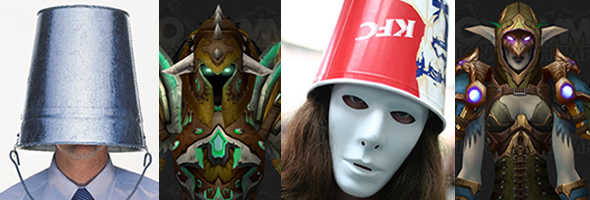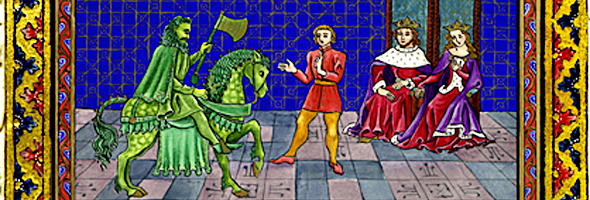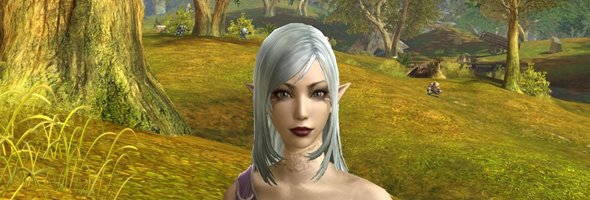
I feel like I should put a disclaimer on this article for WoW fanboys and fangirls, because I am about to shower some praise (and criticism, of course) on a different MMO. I pre-ordered the regular edition of NCsoft’s Aion a couple of months ago, and I’ve been participating in some of the closed betas. Today I’m going to share with you my impressions of the game and speculate about its future playability. I’ll say upfront that I’m not planning, at least for myself anyway, to replace WoW with Aion. I’ve promised Matticus that I’ll stick around in WoW at least long enough to kill Arthas, and I hold to that. However, if Aion is as good as I think it might be, it might become the focus of some of my “casual time.”
The Art of Aion
The number one draw of most games for me is their art. WoW has largely been an exception to this rule. I would call the WoW graphics pleasant, even charming, and I certainly appreciate the ease of running WoW on my machine, but I’d never say that the WoW visuals are breathtaking. I gravitate toward strange, beautiful, and strangely beautiful images, and I was quite pleased to find that Aion has something of the look of a Miyazaki movie. In particular, the pastel desert style landscapes in early Elyos zones recall the visuals of his film Nausicaa of the Valley of the Wind–a longtime favorite of mine. Below, you can see a screenshot of my character hovering over Verteron, which is an early quest hub. I like the mountains and glacial valley in this particular scene, especially as it’s punctuated with prehistoric-looking animals–it gives the world an ancient feel that I appreciate. Some zones are much more pastoral, but in general, the color palette is more muted that WoW’s–it uses more pastels and seems to prefer yellow and brown over blue and red. This look gives an overall impression of age and decadence, which fits the story quite well. After all, according to the game’s lore, we’re supposed to understand that the once-flourishing world was literally split in two by cosmic warfare. The game’s visuals, on the whole, support that claim. I have played mostly Elyos side, but poking around about in the Asmodean starting area I can say that the cooler palette of Asmodae continues the eerie feel of the game as a whole.
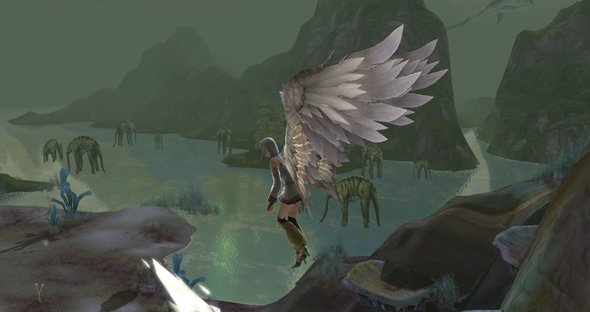
Character Customization
Aion’s spectacularly sensitive character generation tools have probably gotten more press than any other aspect of the game. Unlike WoW, which essentially gives a player a few pre-determined models to choose from, Aion lets the user play with proportions of face and body and minute differences in color to render truly unique player characters. I will say that I still like WoW’s character creator. I’ve logged lots of hours creating my alts and then testing their hairstyles and movements. I also spend much more gold in the barbershops than anyone ought to. However, my need to create compelling characters was not really satisfied until I found Aion. I spent at least 6 hours on character creator, making one unique face at the start of each of my beta gaming sessions. I wish I’d taken screenshots of all the characters I created and destroyed, but I was able to make a mixture of face and body types that referenced different ethnicities. I’ll show you my three favorites: my sorcereress, my cleric, and my ranger.

This is my sorceress, whose name I won’t reveal because I intend to use it when Aion goes live. I created her to look like the main character of the novel I’ve been working on for longer than I’ll admit. So what I have here is a character who’s supposed to look innocent despite a rather odd appearance–prematurely white hair and goth makeup. I couldn’t resist adding the elf ears as a nod to my favorite characters in WoW. The result is more eerie than a generic Galadriel elf type, and I’m very pleased to run around on this character. The character animations and movements have a sort of dainty quality to them that I’ve enjoyed immensely. The picture below is the resting (restoring mana) animation for my character, and I have to say, she looks a bit like Alice in Wonderland in that pose.
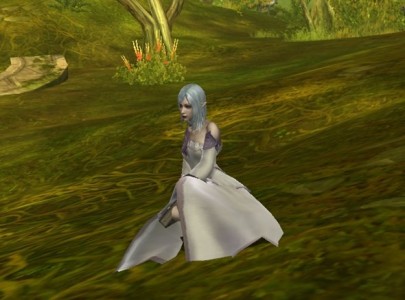
The next character is my cleric, which is the game’s main healing class. I couldn’t resist giving her Syd’s parsley-colored hair. She may be the most beautiful of the three characters I made, but I will have to say, of the three her face is closest to the preset values and thus there are probably many others like her out there.
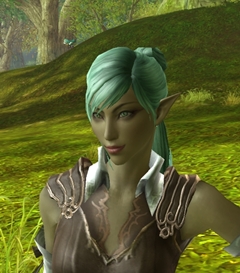
My third character, a ranger, probably took the most time to create, because I used a photograph of a Civil War general to help me approximate the look I wanted. It’s possible to spend hours and hours tweaking an Aion character to look like a photograph. Not all faces can be imitated, and the basic faces do have a certain similarity to each other. I’m not sure how good a job I did with the limited options, but my ranger does have sort of an archaic look that I just love.
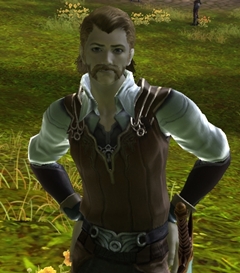
Basic Gameplay
So far, so good, right? Well, if one never looked beyond the quality of the art and character customization in Aion, it would be easy to say that it’s a great game. However, the finesse of the art is not matched by smooth gameplay. I found the basic controls in Aion to be similar to WoW and pretty workable, but I also made extensive use of macros and remapped most of my basic abilities for easier reach. I’m used to dpsing with a certain set of keys in WoW, and I made similar bindings for my sorcerer. However, Aion is certainly playable out of the box. The only exception to this is that the flight controls are automatically mapped to Page Up and Page Down, which are two keys I simply can’t reach if I’m using my mouse. Other than that, the only thing that’s truly egregious about the controls is that the left mouse button is used for click-to-move. Thank goodness that’s easy to unbind. I miss holding down left click to look around as I do in WoW, but that’s a minor thing. My Razer Death Adder mouse with its two thumb buttons simply doesn’t work with Aion, and that’s a pretty big disappointment. I had planned to put my health and mana recovery functions over there. From what I’ve read on the forums, the Logitech gaming mice do work. Sigh.
There are a few other little annoyances related to moving around and doing things in the world. I’m used to WoW, which has cleaned up its interface considerably, so I get frustrated with Aion’s more primitive system. In general, I would say that the controls in Aion are slower. The global cooldown occurs after, not during, a spell’s cast time, so to a WoW player a rotation will feel slow. Gathering also takes a considerable amount of time and uses a clunky animation, as does resting. Picking up quest items can be frustrating because of the game’s phasing system. While questing, you can change channels in order to better share the space with many players. However, I think this causes problems with looting quest items on the ground, as very often your character can’t interact with an object that you can see. In addition, every time you loot a quest item, you have to click a dialog box that says its ok to loot an untradeable item. This gets very annoying while solo questing.
The other thing that bothered me during questing had to do with my character’s voice animations. My sorceress talks too much, and she utters nonsense phrases that unfortunately sound a bit like words in English. I didn’t play the last closed beta, so I have no idea what the North American/European vocals for casting, resting, and hp/mana recovery sound like, but from what I’ve read, they use the same nonsense syllables as in the Korean version, just pronounced in a less “Asian” style. I hate to say it, but I made fun of my character all throughout the betas for her gibberish. For example, when I casted a nuke, my character said something that sounded like “Kick in the PANTS!”, and when I used a bandage, she declared that she was “shittin-n-pissin.” It’s too bad that I need my game sounds to play well. Here’s hoping that the character voices were localized for the NA audience in a thoughtful manner. We’ll see when the final version of the game is released. I don’t think I can play a character that constantly needs to relieve herself (and tell me about it).
I’ll also mention a couple of minor gameplay issues that certainly aren’t game-breaking but might be off-putting to WoW players in particular. When it’s time to learn new skills in Aion, bring a notebook. They are learned on a system similar to Warlock pets’ old grimoires, using spellbooks. It’s easy to miss one or buy the same one twice. I haven’t leveled a character enough to get into the stigma system, which is analogous to specs in WoW. It seems pretty strange and exotic to me.
The other thing that might discomfit WoW healers in particular is a combination of a poor healing interface (think Vanilla WoW) and a lack of support for mods. You simply can’t modify the interface, except with macros. I think mouseover macros would work for healing, but I didn’t try them. The interface made me glad I’d decided to play ranged dps, which even in WoW is not heavily dependent on UI mods.
I’d have to say, though, that the biggest annoyance for any WoW player will probably be the chat commands. They simply aren’t the same / commands that we’re used to, and I end up doing a lot of right clicking and menu searching when I want to say something to a party member. I’m sure I’ll learn the system, but from what I’ve seen talking to others is simply not as easy as it is in WoW.
Flight
Besides the character creation engine, Aion’s biggest selling point is its flight mechanics. At level 10, your character ascends as a Daeva and receives a pair of spirit wings. The drawback is that these wings sometimes work and sometimes don’t–and mostly, they don’t. Many players will use The Lore to explain why flight is sometimes not allowed. There’s some mumbo jumbo about how I have to have pieces of aether nearby to pop my magical wings. I am highly cognizant of the arbitrary nature of The Lore, and I will tell you now that the reason that flight is so severely limited while leveling in Aion is lack of imagination. It’s simply easier to design a ground-based game than one that uses vertical space. I get it, but I end up feeling very ripped off by the limits on flight. First, you can fly for only one minute at a time, and the takeoff animation is going to take up 6-8 seconds of that. Second, gliding, which is basically flying downward with limited use of your controls, only extends this time slightly. Third, once you land, it takes another full minute to restore your flight time. One minute of flight on, one minute off.
I can tell already that flight in Aion is going to be primarily a combat technique. It’s far too limited to be used for travel purposes, even with the flight time extensions that are available in potions and upgraded wings. I wish that the developers had decided to keep combat on the ground (especially PvP combat) and let flight be used as a convenience. As it stands now, flight in Aion doesn’t feel like freedom. It’s actually more efficient to run on the ground if you’re trying to get somewhere. If you want to feel truly free in flight, there’s nothing like the druid flight form, which I’ve been enjoying in WoW for quite some time. I love to shift and reshift, falling in my elf form and catching myself in bird form. That’s just not as easy to do in Aion. I’m hoping for future changes to this aspect of gameplay as it’s one of the most common complaints from North American beta players. However, as the game is already up and running (and wildly successful) in Korea and China, I don’t expect changes before the NA release in September.
One thing I will say about flight in Aion–it’s pretty stylish. Here’s a screenshot that captures the elegance of it. My character uses her extended legs as a sort of tail when she floats, and it reminds me of Nausicaa on her glider.
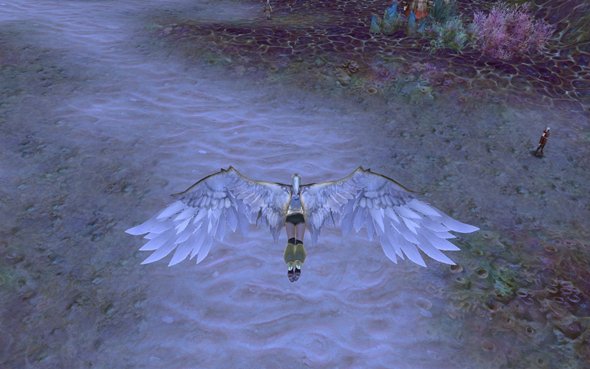
Factions
Aion has two factions, the Elyos and the Asmodeans. Some call them angels and demons, but both groups are perfectly good and perfectly beautiful. I focused on Elyos for my own beta gameplay, but it was a difficult choice and I may revise it later. If I wanted to, say, make a character that looked just like Syd, I’d go Asmo. In the end, the choice will be mostly aesthetic. Do you prefer a white/blue wing palette or a black/purple one? Would you rather look more or less human? Elyos is kind of a vanilla choice, I admit, but I chose them primarily for their resplendent white wings. However, as I’m planning on being a casual player, I’m pretty sure I’ll check out both sides. My guess is that Elyos will be more numerous when the live servers open up, but I could always be wrong.
Classes
There are eight classes in Aion, but there are only 4 starting classes: Warrior, Mage, Priest, and Scout. Each of those classes subdivides into two specific classes at level 10. Essentially, a player’s choice of role is deferred for 10 levels.
In the beta, I’ve played Sorcerer, Cleric, and Ranger. I liked all three, though I’m going with Sorcerer for my main. None of the leveling content is going to present much difficulty for WoW veterans. There are slightly different mechanics. For example, all classes depend on chain attacks for much of their damage. A chain sequences my spells for me. When I hit one of my nukes, I have an option to follow it up with a second special attack. I find the chain attacks really useful. The special abilities are on a cooldown, and what happens over time is that the chains themselves push the player into a rotation that looks something like 1-1-2-2-1-1-1-2-2 without theorycrafting it out. It’s a very tidy way to do things.
As far as class choice goes, I’m going to try to match up Aion classes with their WoW equivalents. Be aware, though, that I’m mostly going by forum posts as I haven’t personally played everything.
Warriors
These guys are your typical buckethead plate wearers (I kid) and the tanks of Aion. The two subtypes are Templar and Gladiator. As far as I can tell, the Templar is the most like a traditional tank, like the warrior of Vanilla WoW. The Gladiator seems to be a bit more like a Fury warrior in tanking gear. However, I haven’t played either of these. The only thing I’ve learned from grouping with them is that the taunt function (called provoke I think) actually raises threat with a mob when it’s either crowd controlled or already focused on the tank. That’s pretty different from WoW.
I have a feeling tank characters will have no trouble getting PvE groups, but I will warn that PvE is not the focus of Aion. Tanks may be fairly strong in PvP, but they’re not widely considered OP in that capacity at the moment.
Mages
The mages divide into Sorcerer and Spiritmaster at lvl 10, which seems to correspond pretty well to WoW’s mage and warlock. I love my sorceress. She is a true glass cannon and comes equipped with multiple means of crowd control and several heavy nukes. I will warn that magical damage can’t crit, so sorcerers should expect to do heavy sustained damage without any spectacular bursts. Sorcerers are strong in all aspects of the game, but they are also delicate. In PvP, they are heavily dependent on getting the jump on opponents, and in PvE groups, they will pull aggro early and often with their CC spells. Only play this class if you’re good at making money and patient when you die.
Spiritmasters are much more durable than Sorcerers and thanks to the cute pets, probably better at soloing. I also hear they’re strong in PvP. I’m not interested in this class myself because I detest controlling my warlock pet in WoW, and from what I read, the Spiritmaster pets take even more micromanagement.
Scouts
Scouts divide into Assassin and Ranger, roughly correspondent to WoW Rogues and Hunters. Assassins (surprise, surprise) are strong in PvE solo content and downright dominant against some classes in PvP. From what I read, good assassins are pretty much a hard counter to the sorcerer. Like any other class, they are dependent on surprise for an easy kill. Rangers are far more delicate than the WoW hunter, but they have the potential to be great in PvP. They are less desired in PvE groups than the Sorcerer, and they also tend to be a bit of a glass cannon in that environment–but this game isn’t really about PvE. The Ranger can stealth, and the ranger can crit–so he or she is a force to be reckoned with in PvP. I’ve played a ranger a bit, and I will say that the one thing that will keep me from making one my main is the movement buffs and debuffs. The ranger doesn’t kite in quite the same way as a WoW hunter. Moving forward will give me a damage bonus, while backing up or strafing will give me a speed/damage debuff. A ranger also can’t really toggle autoattack to weave between shots–I keep having to spam it, resulting in a sore left wrist. I would say that sorcerer and ranger are very similar, but sorcerer is a bit easier (for me anyway) to learn.
Priests
I bet you thought I’d play a priest, didn’t you? So did I. I have to say that I like both the Cleric and the Chanter, the two flavors of priest, pretty well, but I need a change. Cleric reminds me of a holy paladin, which chanter could best be compared to enhancement shaman. The Cleric has a smite spell, which I find pretty funny, and they do low damage while being very survivable. My fiance played a cleric in beta, and paired with a sorcerer, a cleric is definitely a force to be reckoned with. However, he got a little frustrated at the slow pace of soloing. The chanter is quite different from other classes in that it’s primarily styled as a buffer. Now, that’s supposed to make a chanter very desired in groups, but there’s not that many of them around and I’ve never played with one. I’d say the chanter is the closest thing Aion has right now to an underpowered class. If healing floats your boat, go with the cleric. From what I’ve read it seems like playing a chanter would be somewhat like leveling a druid in Vanilla WoW–cast Rejuv, and then melee stuff in cat form. I hope it would be more fun than that, but I’m pretty sure it’s not for me.
Professions and Gear Augmentation
Unlike WoW, Aion lets players level up all the crafting professions, which run the usual gamut of armor and consumable making, almost to full. You can only Master (i.e. max out) one profession. Leveling a crafting profession is quite costly, and the economy is harder to “read” than WoW’s because the currency, Kinah, is exchanged in such high numbers. A calculator is necessary for would-be crafters and Auction House speculators. I think the AH is called the Broker in Aion, but I have trouble remembering. In any case, Aion crafting will be slow to level, because all crafts have chance to fail–and if they do, you lose your materials. I’m a very patient person when it comes to grinds, so I’m looking forward to tougher profession leveling–but I am going to bar my hot-tempered fiance from going near the crafting district. Oh, and you can fail at socketing gems as well, destroying millions of Kinah-worth of mana stones. . . and from all reports, chances of failure actually increase with higher-level items. This is a very hardcore crafting and item enhancement system, folks, so be patient with it.
PvPvE
As I’ve said at least twice, this is not a PvE game. The whole purpose of leveling is to get to the Abyss, where you can earn Abyss Points for participating in kills on enemy players. The best armor in the game is earned exclusively through Abyss points–so you tell me where the focus is. From what I’ve read, the Abyss is less like a formal battleground and more like the old epic battles at Southshore. Opposing armies zerg each other, and strength in numbers is the way to win. Aion’s neutral faction, the NPC demon Balaur, always come to the assistance of the outnumbered side. I’m reserving judgment on this one until I see how it works. It could either be great fun, or it could be buggy and easy to exploit. In any case, if I play Aion for any length of time, even I will have to PvP.
Game Economy
It seems to me that most things in game–from great craftable gear to mana potions–can be bought pretty easily either from the Broker or from player stores (the equivalent of trade chat). The values for Kinah seem really inflated to someone used to either United States currency or WoW currency. It wouldn’t be strange to see an item sell for, say, 10 million Kinah. I think the choice of “Kinah” is unfortunate because of the ambiguity with the abbreviation K for thousand. We’ll see how the game and game terminology shakes out. Players may end up abbreviating Kinah KI or KN to disambiguate.
There are certainly gold sinks in the current game. Crafting is probably #1. I am planning on mastering alchemy, as sorcerers are really dependent on mana potions, and I’m usually good at selling things. However, it’s unclear whether selling will ever be profitable in Aion as, over time, players can become self-sufficient by leveling all the consumable professions almost to the max. We’ll see. My darker prediction is that with high prices and few ways to earn, gold buying will become really common.
The other gold sink is death–analogous to repairs in WoW. Each time a player dies in PvE, experience is lost unless you’re willing to pay…and I always am. As a sorcereress, I die a lot. I’m just going to have to find a way to make the Broker system work for me because I’m simply not going to either buy gold or stop dying so much.
Conclusions
Aion is not a perfect game. Neither is WoW. I’d say on the whole that WoW suits me more as a player–large scale PvE raiding is just something that Aion doesn’t offer. I’d also say that I vastly prefer WoW’s interface and mod-using capability. But for PvP or leveling content I might go with Aion. It feels like time for a change, at least for a couple hours a week.
